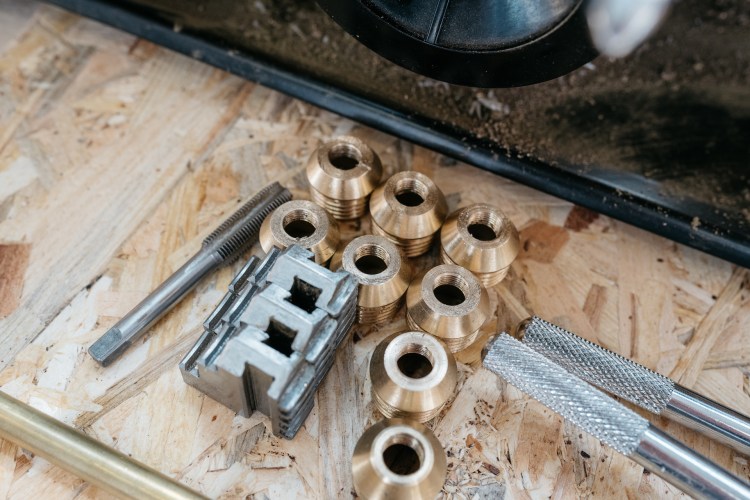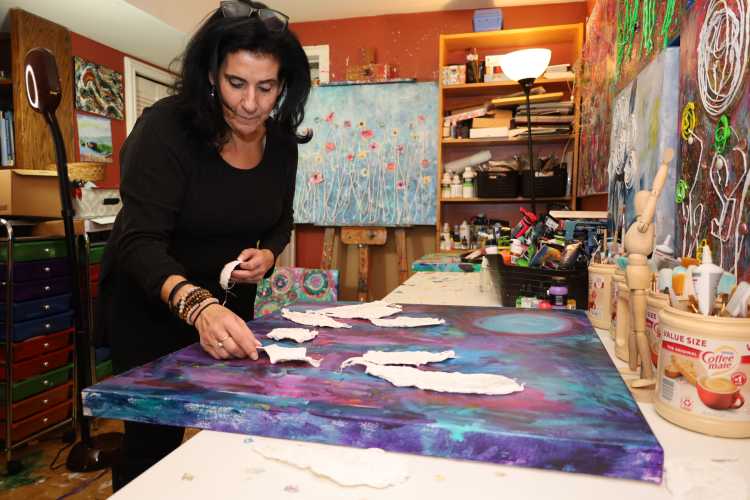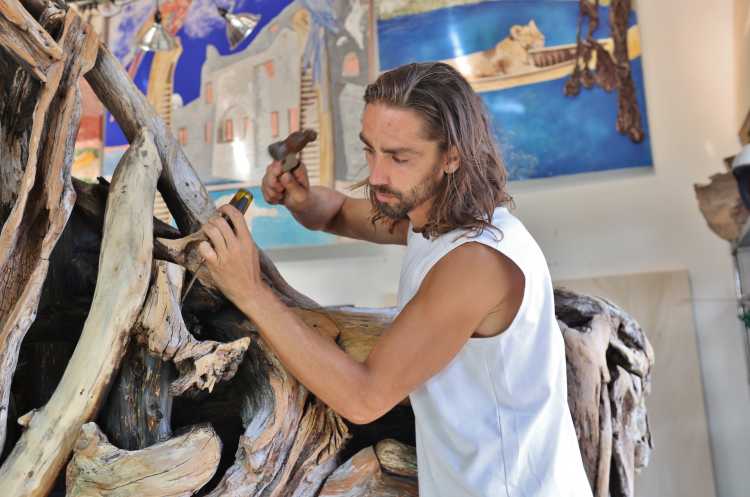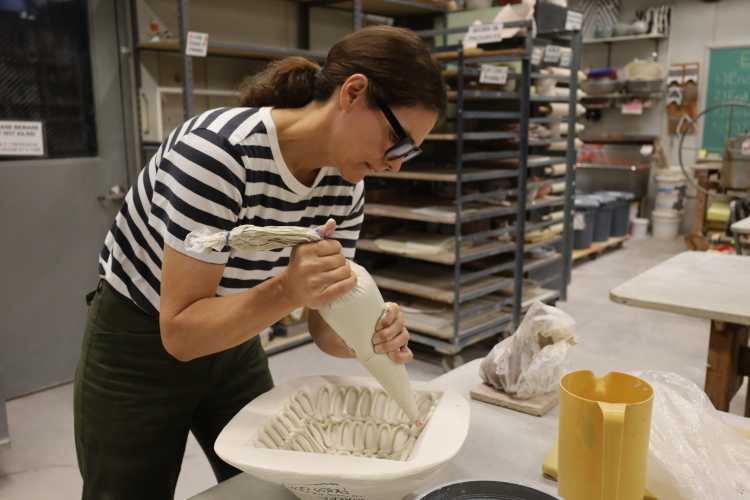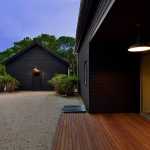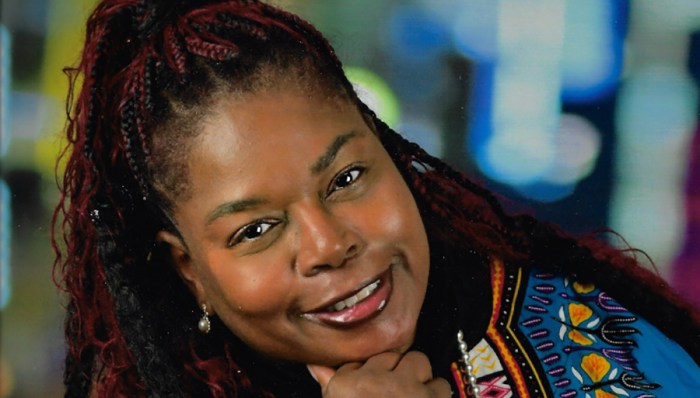Joseph Sidof, founder, chief executive officer and creative director of Shakúff Bespoke Lighting Solutions, was commissioned to design lighting for a kitchen in a Southampton house on the beach.
He created raindrop fixtures that blended with the ocean view beneath a metal canopy, providing a beautiful lighting fixture that did much more than illumine the space.
“Each raindrop has a lightbulb. We’re talking about maybe 250 pendants with blown glass and light bulbs,” Sidof says. “We created a statement in a kitchen island in a Southampton house on the beach.”
While most people use light to see other objects, Brooklyn-based Shakúff specializes in designing artistic lighting fixtures that, themselves, are worth looking at. These typically glass and metal fixtures (sometimes with other materials such as wood) can light up a room literally and figuratively.

“On Long Island, I do a lot of entryways and foyers when people want customized lighting,” he says, noting his company also does lighting for living and dining rooms, as well as kitchens, bedrooms, stairways and almost any possible space. “Long Island is a very strong market for us. Usually, it’s new construction. We also get a lot of remodeling of houses.”
Sidof works primarily with interior designers as well as some “creative homeowners,” crafting fixtures with the proper look, measurements, and proportions.
“I work with interior designers who have a vision. They come to us, sometimes with ideas very specific for the space,” Sidof says. “Many times, they show me the dimensions. They might pick the glass.” Designs from Shakuff (which means “transparent” in Hebrew) can go from $300 for a single pendant to many thousands of dollars with designs they did and sell at shakuff.com, supplementing their custom-made business. They can adapt a $40,000 fixture to about $8,000, making it smaller and otherwise modifying.
Sidof says about 80 percent of their work is custom with about 20 percent, primarily through the website, that they make, but don’t customize. Premade products take six weeks, while customized ones typically take eight to ten weeks.
“Sometimes I bring colors into the light,” he says. “Sometimes the view is so beautiful, I have to be minimalistic with the color.”
Some people come to their main Brooklyn showroom to discuss design or go to showrooms including their work, such as Island Final Touch in Syosset, one of 28 showrooms carrying the work nationwide plus one in Dubai.
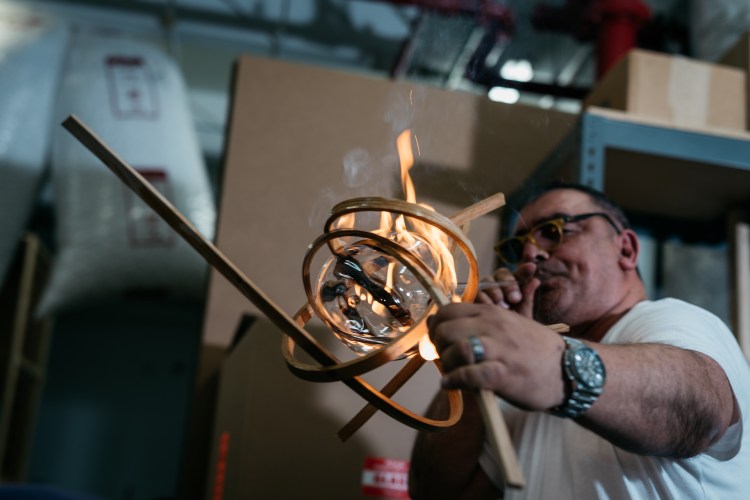
“I always like to ask people what they like, what they’re feeling,” Sidof adds. “Based on that, the space, the dimension, drawings, pictures, video. Sometimes we offer a visit to see the space.”
They create 3-D images to show the look, before making lights, including blowing their own glass (which others at his company do), dealing with “the process from A to Z.”
While they buy raw materials such as glass that they blow and metal tubes that they bend, “We make the whole thing,” Sidof says.
He is sometimes deeply involved in details, while others sometimes take the lead and manage details. “I know how to design the glass, my vision,” Sidof, who worked in jewelry before this, says. “What I want to achieve with the glass. I know technique.”
He talks about a house where the owner wanted “not just a chandelier, but a statement” with shapes branching from the ceiling to walls. “We actually made a new design,” Sidof says. “It’s literally a branch we made out of bending metal pieces starting from the ceiling. It continues to branch into the wall. The entire room fills up with metal pieces and blown glass attached to them. It functions as lights as well as an artistic statement.”
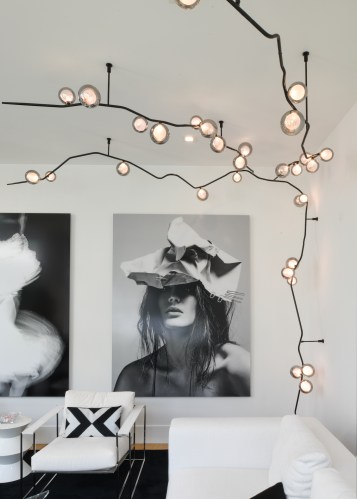
finish and reaches across the space, climbing
down the wall and across the ceiling.Matthew Corona Goldstein
He likes to use “warm light” that is soft and yellowish, sometimes using bright white, multi-colored or lights with changing shades.
“It’s not, ‘make me a chandelier.’ It’s make me a statement piece. Make me a piece that looks like a butterfly, stars, the moon,” Sidof says. “Make me a universe. I make blown glass look like stars mixed in with moons and galaxies.”
He makes designs with minimalistic wires that look like candles coming not from tables, but ceilings. “When you look at a chandelier or pieces, you don’t really see the wires,” he continues. “You see blown glass. You don’t see the light bulbs. You see a piece of art in your space.”
Sidof fell in love with light as a child, growing up in Haifa, spending time at beaches, enjoying water, sand and light.
“I liked to be outside. That developed my appreciation of nature and beauty. Playing with shells, natural spaces,” Sidof says. “I love to bring nature and outside beauty into people’s spaces.”
He says LED changed the game, requiring fewer light sources and bulbs and allowing smaller pieces as well as vertical and horizontal lighting with LED strips and more dimming options.
“If it’s a large tube, I can have brightness on the top and lower it at the bottom, so you have different effects,” he says. “That’s all because of LED.”
Designs often use fewer wires and more single rods with bulbs emerging like bouquets. People are using more metal and glass, combining materials. “It changes the mood,” he says. “I’m very affected by lights. Lights change your mood.”
He is using sensor technology to replace dimmer switches and provide a touchless way to manage dimmers on LED table and floor lamps. “You don’t need a switch,” Sidof adds. “You move your hand to turn it on and off. You can dim it by putting your hand closer.”

They design for clients around the world and install in the New York metropolitan area, including Long Island, but fixtures are designed for any electrician to install.
In the Southampton house where he used a raindrop design, Sidof also made a sculpture with painted glass and a light box, so the light illuminates the glass.
“It has blue textures like ocean. It’s the aesthetics of the space. If it’s an ocean view, I have to design pieces of glass that blend with the view,” Sidof adds. “If it’s a different space, I design a different type of glass, with more texture, more colorful.”
While many people think custom-made lighting matters most at night, Sidof says the art work is most visible and beautiful all day long, even when the light may be off. The beauty, he says, can be very visible even when it’s not emitting light.
“A lot of people think about lighting in the night. I appreciate lighting during the day. I think you can see more beauty in fixtures during the day,” he says. “At night, you might have the light, but during the day, when there’s no light, so it’s not being used as lighting, you can appreciate the pieces.”
This article appeared in the June 2024 issue of Behind The Hedges Powered by the Long Island Press. Read the full digital edition here. It will also appear in the June 14, 2024, issue of Behind The Hedges Dan’s Papers. For more Master Craftsman articles, click here.
